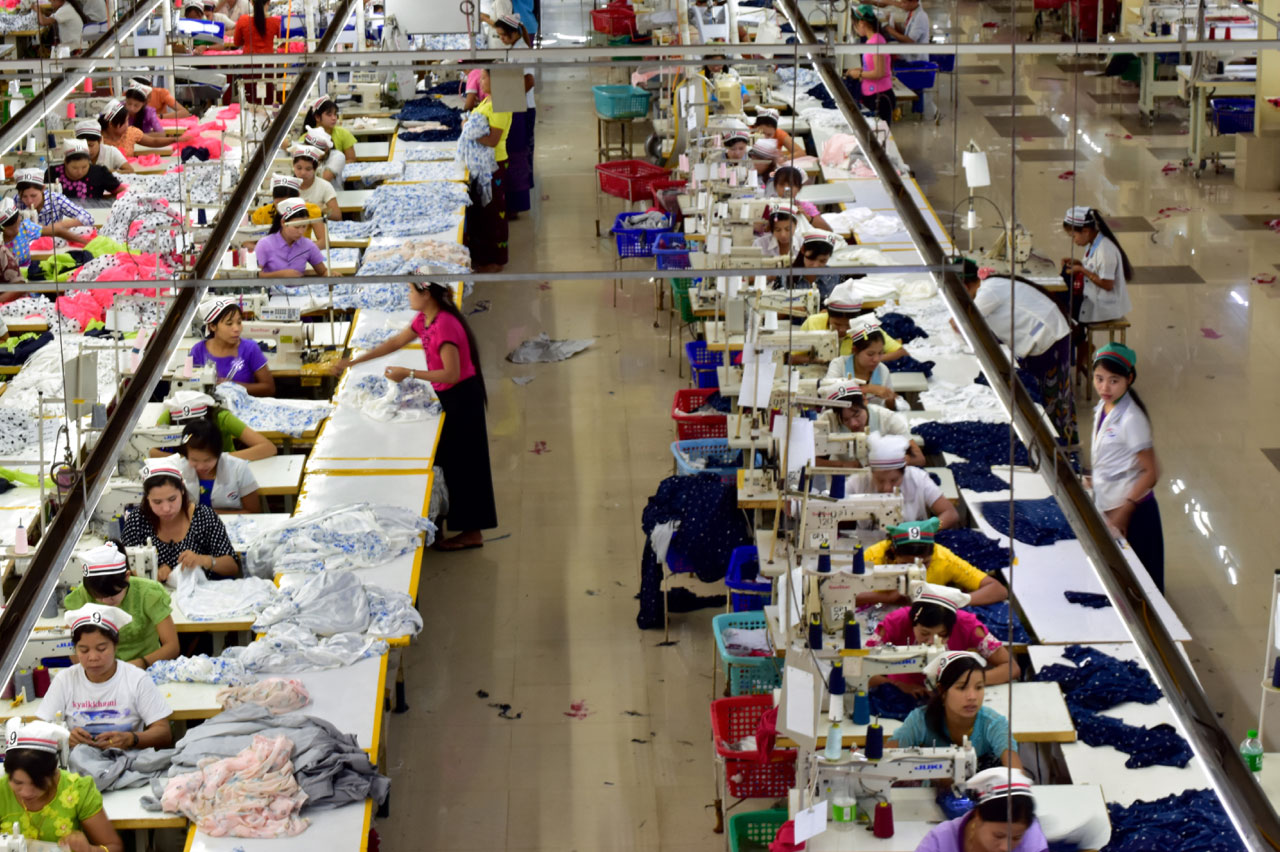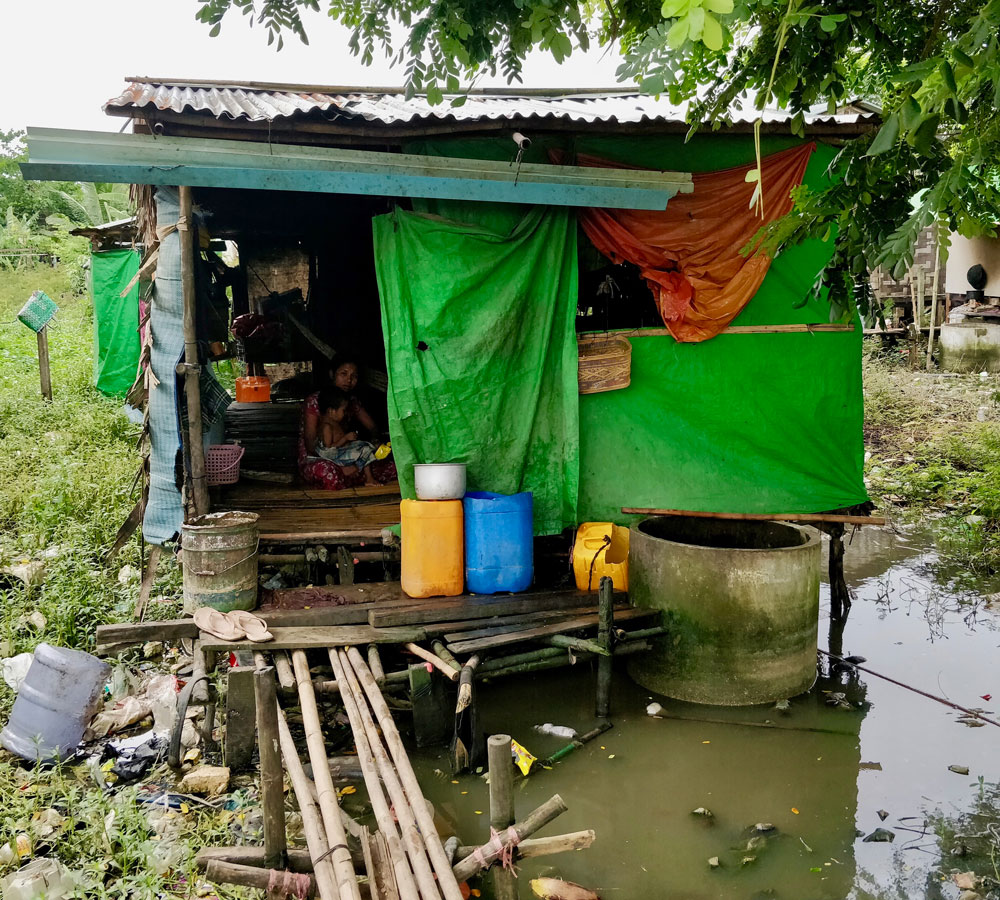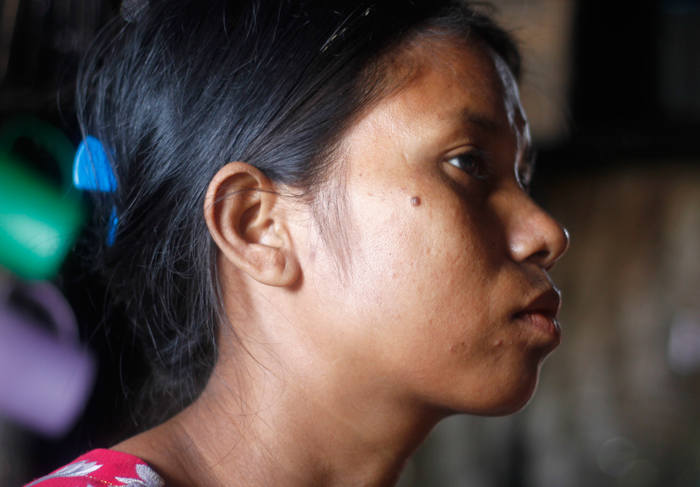13-year-old Ei Ei Thein knows little of school life – she’s never been. But she could not have been more proud of the borrowed uniform she wore during a recent visit to one of the many scrap-dealers scattered through the slums circling Yangon.
A pile of bottles spills beside her bare feet. These, she knows well – as well, if not better, than any 13-year-old schoolkid knows her arithmetic or grammar. She can recite the numbers by heart: fifty kyats – barely three cents – for a beer bottle, 20 kyats for a whiskey flask, the same for a plastic bottle.
Since her family moved from Myanmar’s Ayeyarwady Delta to its biggest city four years ago, Ei Ei Thein and her two younger brothers pass long hours collecting recyclable bottles from rubbish tips and sewage channels. In the hot season, the sun beats down on their backs as the temperature climbs above 40 degrees. In the longer rainy season, they are battered by thunderous downpours.
It’s ugly work. Broken glass sometimes pierces her hands and feet. She still fears stray dogs after a bite from one left her with scar running through her right eyebrow. But Ei Ei Thein and her two younger brothers bring in around US$2 a day – money her family needs to stave off the nagging hunger and maintain a tenuous hold on the weather-beaten rented shack they call home.
“We left our village with the hope of making life comfortable. Hope is the core of everything”
Win Maw
After Cyclone Nargis devastated the delta farming region in 2008, tens of thousands of families flocked to Yangon’s slums. This exodus has not let up during the country’s transition from military rule, as the draw of new factories and construction work pulls people from countryside to city.
According to the 2014 census, 9.39 million people – nearly a fifth of Myanmar’s population – were counted as internal migrants, a number that looks set to increase as a vortex of extreme weather, failed harvests, rising debt, land confiscation and price fluctuations drive people from the delta and central dry zone.
Yangon’s sprawling jerry-built slums lack running water and electricity, leaving them ill-equipped to cope with the flood of people.

Gazing out from the family hovel, set just inches above a trash-choked quagmire in Dagon Seikkan township in eastern Yangon, Ei Ei Thein’s mother Win Maw looks exhausted. Cradling a toddler in her arms, she reflects on the grinding rural poverty that drove her young family to take their chances in the big city.
“We left our village with the hope of making life comfortable,” she says.
A month into the monsoon season, the rain batters the ripped tarpaulin shielding her home. The downpours swell the trash and mud underneath. It’s not long before the bog outside wells up through gaps in the bamboo floor where Win Maw sleeps – along with her four children and father-in-law.
Hours earlier, Win Maw was on the end of a tirade delivered by an irate landlord standing on the muddy road running outside the shack.
Her rent has doubled to 40,000 kyats (US$26) over the years since the family moved into the shack – more or less the entire amount Ei Ei Than and her two brothers can earn from scrambling over refuse heaps in their daily scavenge for bottles.
“Last month me and grandfather were ill and we couldn’t pay the rent,” said Win Maw. “We wanted to run away. Some other families are doing better than us because they have older children who can work in the garment factories. I can’t, because of the baby.”
The poverty seen in Yangon’s slums is as precarious as it is grinding. A small setback – be it as innocuous as a toothache or as inevitable as a storm – can send poor families over the edge financially. But Win Maw is resilient, recently enduring a stillbirth and now persevering without her husband, who left them a few months ago to look for a job on a building site. He hasn’t returned.
Despite their troubles, she agreed with her father-in-law, San Lin, 67, that coming here was the right move. “Hope is the core of everything,” she says.
“In their very young lives, these children have experienced parents drinking, maybe beating them”
SONNE Social Organisation chairwoman San San Hla
It’s a view shared by organisations assisting Myanmar’s millions of internal migrants.
“Life in the countryside is even worse for them,” says San San Hla, 52, chairwoman of SONNE Social Organisation and a three-decade veteran of migrant support work.
The economic data supports San San Hla’s view, with about one in four adults in Myanmar earning less than 1,590 kyats ($1.06) a day, according to a 2017 survey supported by the World Bank and UN. The report found that rural areas have a poverty headcount almost three times higher than cities.
While farm life is dictated by the seasons and the timing of the rice harvest, collecting bottles is year-round work that the three oldest children do come rain or shine.
Ei Ei Than’s bottle-collecting team is made up of brothers Bo Bo Naing, 11, and San Lin Naing, 7. The older boy’s passion, like millions of others his age, in Myanmar and all over the world, is playing football. San Lin Naing – still too slight to kick a ball around with the older kids – loves to paint.
A life picking through the mud and drains has endowed the two boys with a more down-to-earth outlook than most children their age. They do not dream of becoming footballers or painters, but have their sights set on some of the typical jobs they see men doing. Perhaps they will be construction workers, like their absent father, or motorbike taxi drivers.
Myanmar’s booming apparel industry has drawn many workers from the countryside to earn a living in the garment factories circling Yangon. Photo: Simon Roughneen

Ei Ei Thein dreams of dancing, but, like her brothers, she has her feet firmly on the ground. She’s hoping for a job sitting behind a sewing machine in one of the hundreds of garment factories that ring Yangon.
An apparel job would bring in $200 a month – money-enough to transform their slum lifestyle.
A ten-minute drive from Ei Ei Thein’s home, the SONNE centre has stacked sewing machines in preparation for teaching older children the trade.
By around 9AM, 43 children have trickled into the centre, donned red t-shirts and sat down for breakfast. The charity provides them with lunch, too, and a programme of language, social and hygiene lessons along with meditation, games and handicrafts.
SONNE says it aims to help better integrate the children into society and, ideally, see them enrolled in a government school.
“In their very young lives, these children have experienced parents drinking, maybe beating them,” says San San Hla. “They have not got enough love, so we have to build them up and show them love, that they are something special.”
Nearly all of the children share the stress of working for a pittance to ensure their families survive. Some sell jasmine at traffic lights or pluck chickens and scale fish at local markets.
“They have no chance, they can only live day-by-day and they cannot plan for the future,” said San San Hla.

Win Maw shares her makeshift shack with her four children and father-in-law. Photo: Lorcan Lovett
Many of their families scraping a living in Yangon’s slums have no legal claim to the land they live on, leaving them vulnerable to eviction – sometimes to make way housing plans devised by the regional government.
Devised behind the starch-white walls of Yangon City Hall, a 40-minute drive from Win Maw’s shack in Dagon Seikkan, the proposed construction of so-called “affordable” housing was portrayed as a way to allow some of the urban poor to get some small share of the city’s growing wealth.
But of the 38 slum households interviewed for the 2015 study “On the Frontier of Urbanization: Informal Settlements in Yangon”, none could afford one of the units.
Eben Forbes, the study’s author, has come up with what could be a work-around: if the government can’t afford to build housing for everybody, it could at least provide plots with water and sanitation while squatters build their own dwellings.
The city’s internal migrants should be given communal plots and land leases, Forbes believes – measures that could help prevent more squatting, so long as landholders were prohibited from selling plots to wealthier outsiders.
The city’s economy would in turn benefit from a large pool of low-wage labour and spin-off micro-businesses, explained Forbes, a former UN-Habitat Myanmar program officer.
“Solutions will generally arise only once squatting is understood as a respectable choice for many poor people, and from taking the strategic view of low-income families as an economic asset to the city, rather than a burden,” he adds.
The threat of eviction, he says, “should be considered only as a last resort”.

“Eviction is bad for everyone: traumatic for the residents, and also bad for Yangon City Development Committee’s relationship with the public,” he says. “And it only leads to squatting in another location.”
San San Hla has seen migrants priced out of their shacks and pushed on to create new peripheries around the densely populated city.
“A few years ago there were no proper streets here or infrastructure at all,” she says. “Now you have streets, it’s easier for people to come. People are buying up the land and building new houses.”
When asked what they want to change about their lives, brothers Bo Bo Naing and San Lin Naing’s answers were unsurprising.
“A proper house,” says Bo Bo Naing.
“I would like a proper house, and lots of cars, and I need a bicycle,” adds the youngest, San Lin Naing.
For now, the siblings will have to settle for a bit less – a dress for Ei Ei Thein, a t-shirt for the boys, and footwear for all three – all courtesy of San San Hla, who suggested that it was the first time in their lives they have been bought new clothes.
Later, passing one of the stretches of rubbish where the three children often comb through the piles of waste, Ei Ei Thein climbed out of the SONNE truck bringing them home as her brothers looked on. Now, with her new sandals fastened tight, she doesn’t have to worry about broken glass shearing through her bare feet.
Peering down at the limbs of a plastic toy poking out from under the leaves and mud and rubbish, Ei Ei Thein lamented another legacy, like her lack of schooling, of a childhood lost to poverty and hard labour.
“If I could change something that would make me more happy, it would be to play with Barbie dolls,” she says.


